Where would you go to hear the most electrifying and collegial orchestral playing in the world? It used to be Lucerne while Claudio Abbado was alive. Now that the Lucerne Festival Orchestra has become like any classy superband, the answer is Pärnu in the south of Estonia.
It's a modest town of nearly 40,000 inhabitants, but its numbers treble in the summer, with visitors flocking to the eight-mile, south-facing white sand beach and the wooden villas in beautiful parkland (David Oistrakh and Shostakovich travelled westwards to Pärnu for their summer holidays). It also boasts a 900-seater concert hall, its 2002 inauguration having much to do with the championship of Estonia's musical royal family, the Järvis.
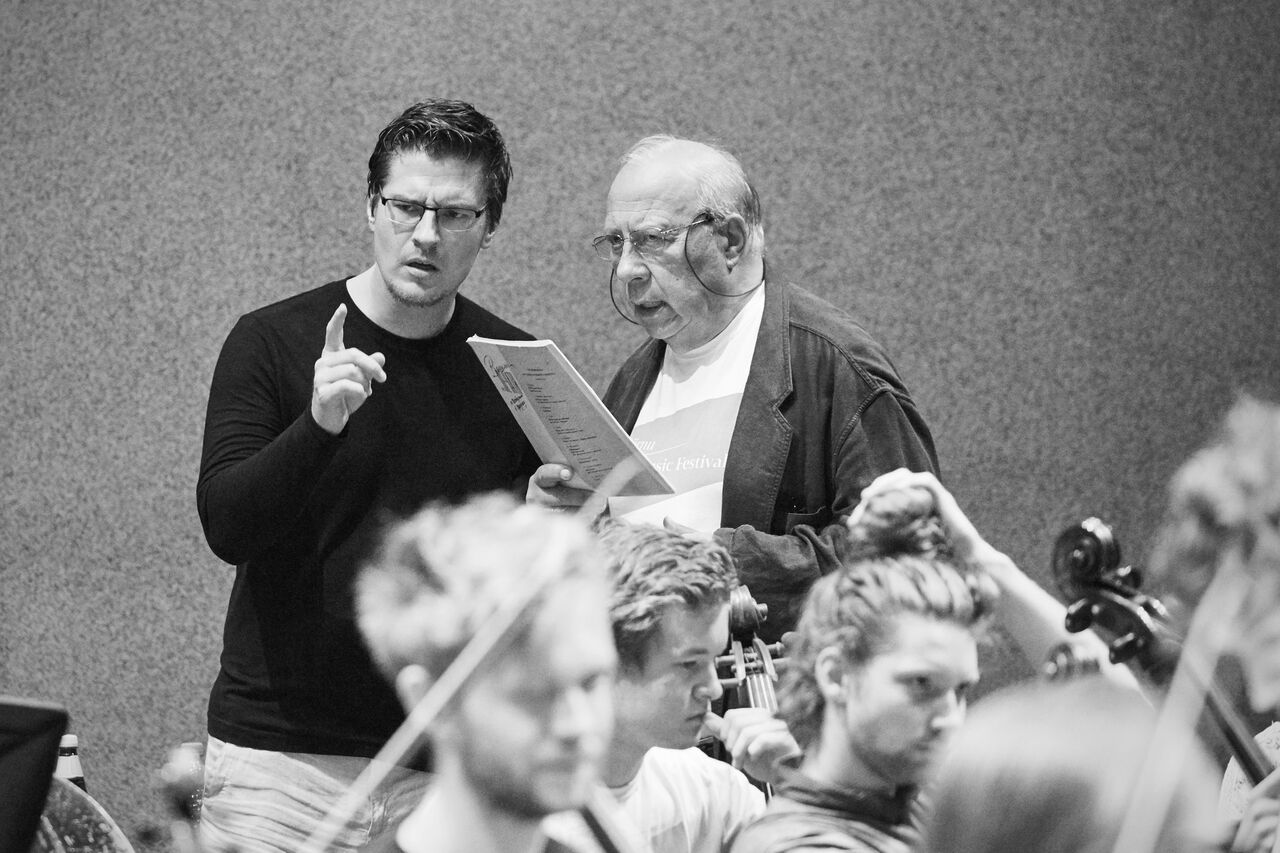 Neeme Järvi, 80 next year, and the elder of his two conducting sons, Paavo - Kristjan came along last year - are now indisputably among the world's top 10 conductors. They run masterclasses in Pärnu for young aspirants from around the world (pictured above: Andres Kaljuste and Neeme Järvi) in conjunction with a superb Academy Orchestra made up of mostly Estonian music students. You'll find the names of no less than 10 Järvis in the programme biographies; Neeme's and Lillja's daughter Maarika is a world-famous flautist, while his nephew, cellist Teet, has five musical offspring. The jewel in the Pärnu festival crown is the heady mix of top western and Estonian players in what after five years has now become the Estonian Festival Orchestra.
Neeme Järvi, 80 next year, and the elder of his two conducting sons, Paavo - Kristjan came along last year - are now indisputably among the world's top 10 conductors. They run masterclasses in Pärnu for young aspirants from around the world (pictured above: Andres Kaljuste and Neeme Järvi) in conjunction with a superb Academy Orchestra made up of mostly Estonian music students. You'll find the names of no less than 10 Järvis in the programme biographies; Neeme's and Lillja's daughter Maarika is a world-famous flautist, while his nephew, cellist Teet, has five musical offspring. The jewel in the Pärnu festival crown is the heady mix of top western and Estonian players in what after five years has now become the Estonian Festival Orchestra.
Is the Lucerne parallel far-fetched? Only in terms of the money - this is a modestly-funded labour of love - but certainly not when you consider the calibre of the instrumentalists. I keep on clocking great musicians: in 2015, among others, the Scottish Chamber Orchestra first horn Alec Frank-Gemmill and the leader of Jarvi's Kammerphilharmonie Bremen as well as of the EFO, Florian Donderer; this year, Esko Laine, Finnish-born principal double-bass of the Berlin Philharmonic, and Vladislav Lavrik, principal trumpeter of the Russian National Orchestra. Paavo's guiding idea from the start was to have a free-spirited western musician sharing a desk with an Estonian to loosen up the playing style. and it's worked for all concerned. Florian said to Paavo while we were in conversation that he thought the violins were better than ever this year, and it's hardly surprising when you've got a young virtuoso of the calibre of Russian-born Dunja Lavrova sitting on the back desk of the firsts with an even younger Estonian of promise, Guildhall student Marike Kruup.
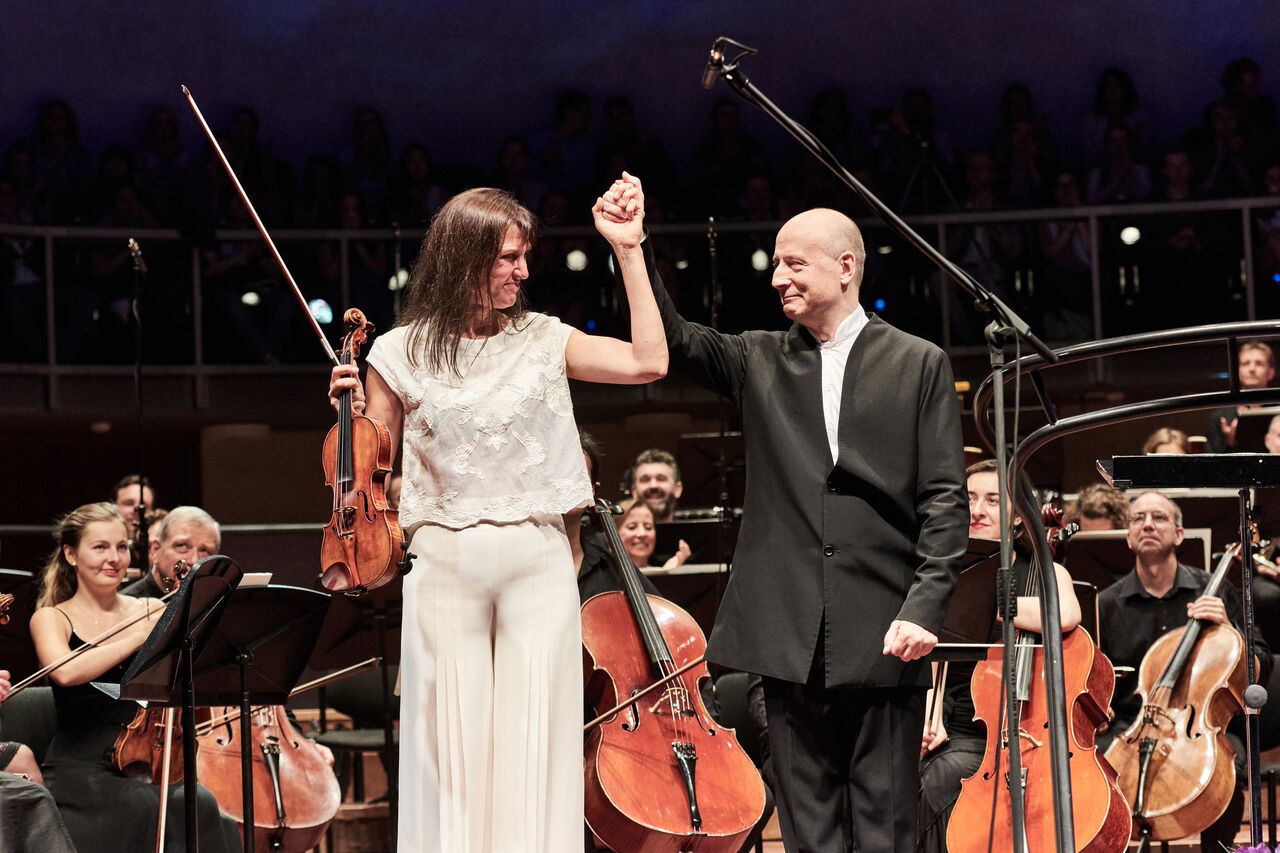 It was a given that the two EFO concerts this year would be up to the same breathtaking standards as their counterparts last year. Sibelius and Nielsen hadn't made the programme in anniversary year, but they were here in 2016, and how: Viktoria Mullova (pictured above with Paavo Järvi and the EFO) played the Sibelius Violin Concerto with an intensity I've never heard from her before, so evidently enjoying the equal freedom of her fellow musicians (Mullova Smiles!) and turning much of the work into the best kind of improvisation. And when did you ever hear it so that the two clarinets leading towards the main matter of the slow movement make as much of an impact as the soloist's melody?
It was a given that the two EFO concerts this year would be up to the same breathtaking standards as their counterparts last year. Sibelius and Nielsen hadn't made the programme in anniversary year, but they were here in 2016, and how: Viktoria Mullova (pictured above with Paavo Järvi and the EFO) played the Sibelius Violin Concerto with an intensity I've never heard from her before, so evidently enjoying the equal freedom of her fellow musicians (Mullova Smiles!) and turning much of the work into the best kind of improvisation. And when did you ever hear it so that the two clarinets leading towards the main matter of the slow movement make as much of an impact as the soloist's melody?
Paavo Järvi had conducted the Philharmonia Orchestra earlier this year in Nielsen's Second ("Four Temperaments") Symphony. But he just couldn't get them to burn. Here, though, you got not just the four temperaments - which, of course, are aspects of Nielsen's own Geminian personality - but a hundred, personalities expressing their love of the music but still playing as one.
This is a string sound you'd go a long way to find, but curiouslysomething like it was to hand, too, in the Academy Orchestra when the great Neeme conducted them in the encore of their big evening, Sibelius's Andante Festivo, a great favourite of his: I heard it several times when the emigré returned to Estonia at a difficult time in 1989 to give concerts with his Swedish orchestra, the Gothenburg Symphony. Suddenly the already sleek Academy strings sounded like the Berlin Phil - or perhaps in the circumstances one could just say like the older sibling which inspires their progress and their sense of fantasy, the EFO. (Pictured below: Paavo and Neeme Järvi at the end of the concert; the third conductor-coach this year, Arkady Leytush, is just behind them.)
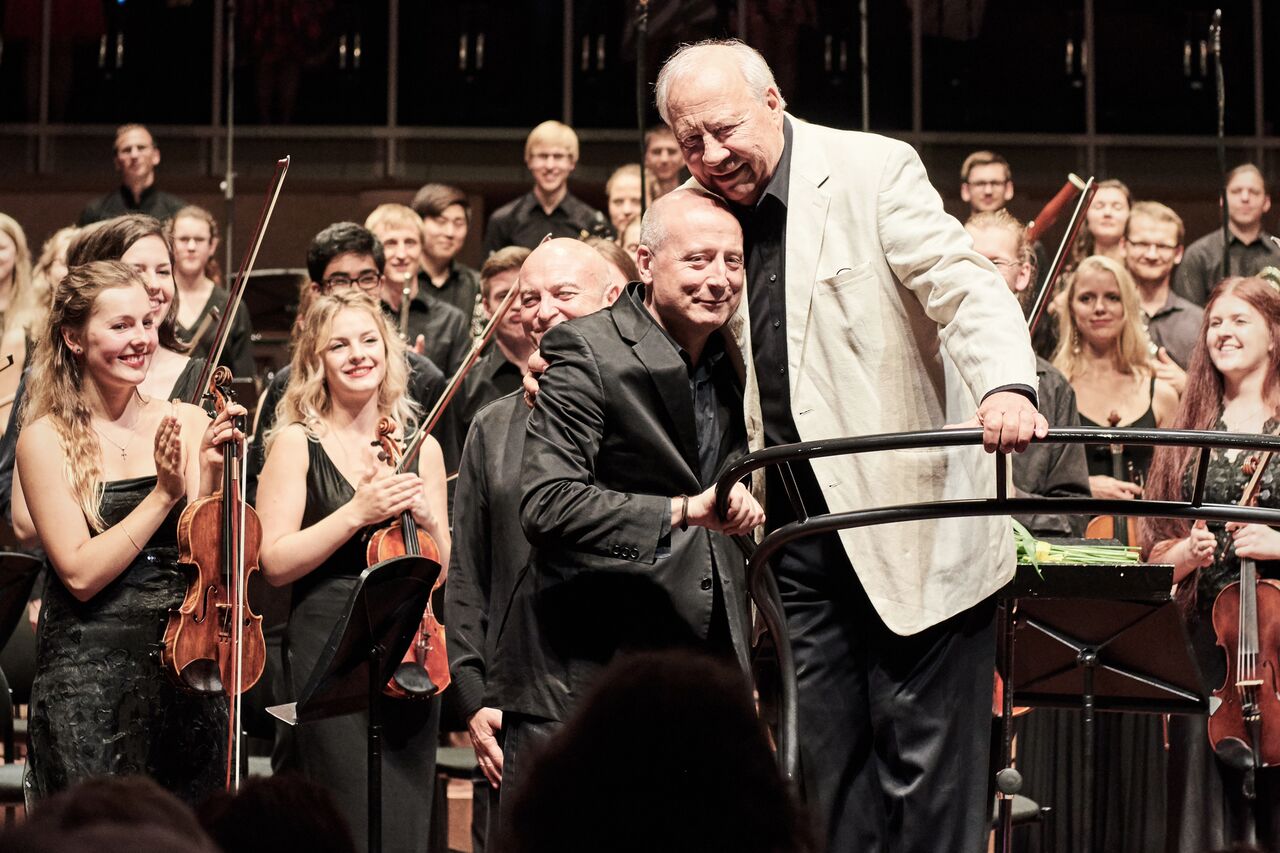 Neeme doesn't give the conductors on the Academy course a conventional time; last year the major symphony for study was Tubin's Sixth, and this year he opted for Prokofiev's massive 1947 Soviet reworking of his ballet-based Fourth Symphony. There were more conductors than last year on the course, 18, though only eight got to perform in the final concert, taking a movement apiece of Rachmaninov's Second Piano Concerto with a young Estonian of promise, Sten Heinoja, as the soloist, as well as of the Prokofiev.
Neeme doesn't give the conductors on the Academy course a conventional time; last year the major symphony for study was Tubin's Sixth, and this year he opted for Prokofiev's massive 1947 Soviet reworking of his ballet-based Fourth Symphony. There were more conductors than last year on the course, 18, though only eight got to perform in the final concert, taking a movement apiece of Rachmaninov's Second Piano Concerto with a young Estonian of promise, Sten Heinoja, as the soloist, as well as of the Prokofiev.
Andres Kaljuste, the viola-player in the EFO who is acquiring his wings now in Finland, was given the opening work as befitted his experience, Estonian Veljo Tormis' Ouverture No. 2 of 1959 with its moments of Janacekian intensity; the conductor stayed clear and collected. Of the others, the Rachmaninov made clear judging difficult. I was sorry not to see Margarita Mikhailova among them; her batonless shaping of the Prokofiev in the masterclasses seemed promising, helped along by Neeme's irrepressible how-to-do-it encouragement.
Linger in Prokofiev's more expansive moments and you're lost. That was probably why Spain's Irene Gomez-Calado didn't do so well in the rambling second movement; and the finale, swivelling from trumpet sarcasm into full-blown Soviet apotheosis with irony between the lines, stumped Chile's Gonzalo Farias. On the plus side, Germany's Stefan Bone negotiated every tempo-change in the thrillingly expanded first movement to perfection, and Jonathan Bloxham, another Festival Orchestra player, made elegant work of the ballet music (the dance of the Siren from The Prodigal Son) in the scherzo.
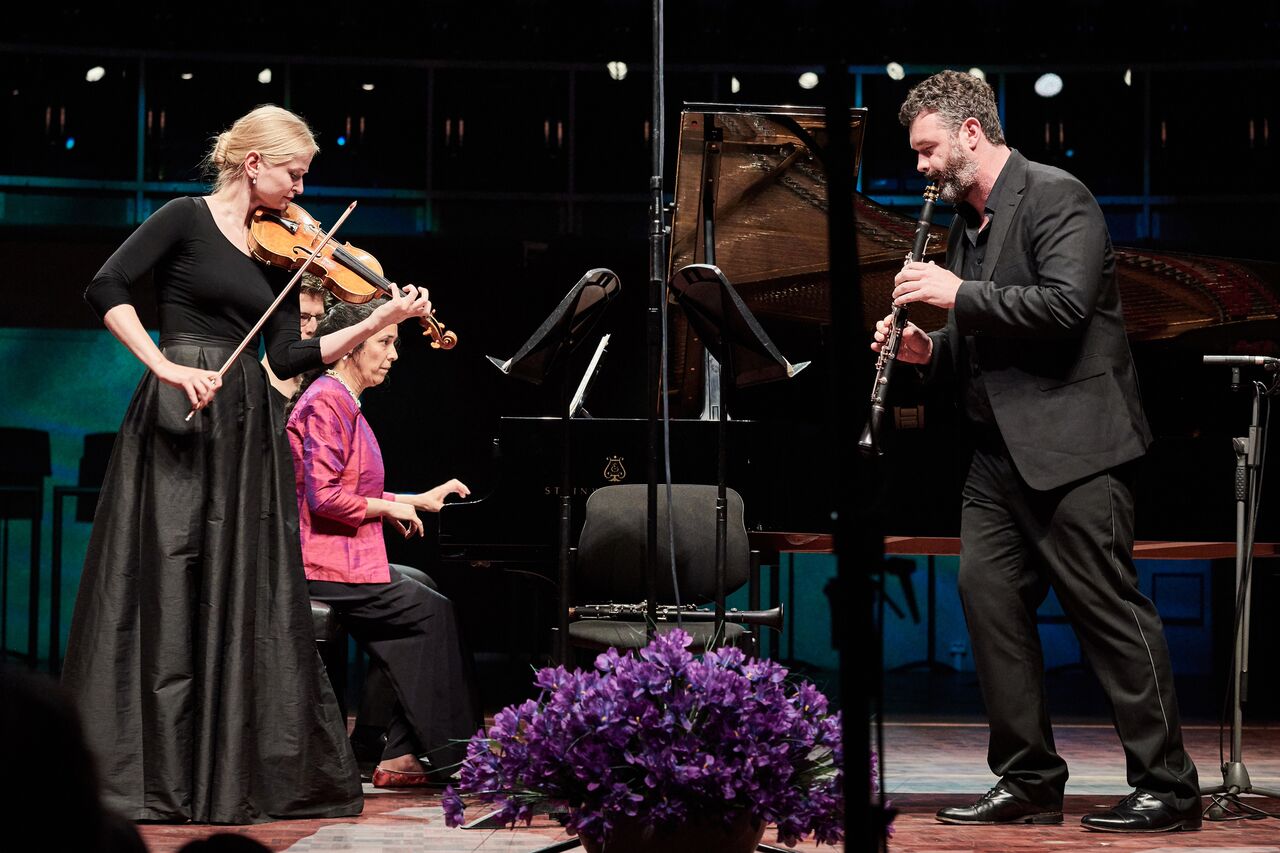 Between the big concerts, there was a chance to gauge the EFO soloists’ skills at closer quarters. As in 2015, a three-part, three-hour chamber music gala, brought revelations as stunning as anything in the EFO’s full symphonic events. Destined to be a highlight from the start, on the strength of his unforgettable duetting with bassoonist Martin Kuuskmann last year in Strauss’s Duett-Concertino, was clarinettist Matthew Hunt’s takeover of the Benny Goodman role in Bartók’s Contrasts. His duettist and duellist this time was violinist Triin Ruubel, with supreme chamber-musical responsiveness in between from the wonderful pianist of the week Sophia Rahman (all three pictured above). Hunt is equal best among the world’s clarinettists with the likes of Kari Kriiku and Martin Frost; better or more vivid than this it’s not possible to go.
Between the big concerts, there was a chance to gauge the EFO soloists’ skills at closer quarters. As in 2015, a three-part, three-hour chamber music gala, brought revelations as stunning as anything in the EFO’s full symphonic events. Destined to be a highlight from the start, on the strength of his unforgettable duetting with bassoonist Martin Kuuskmann last year in Strauss’s Duett-Concertino, was clarinettist Matthew Hunt’s takeover of the Benny Goodman role in Bartók’s Contrasts. His duettist and duellist this time was violinist Triin Ruubel, with supreme chamber-musical responsiveness in between from the wonderful pianist of the week Sophia Rahman (all three pictured above). Hunt is equal best among the world’s clarinettists with the likes of Kari Kriiku and Martin Frost; better or more vivid than this it’s not possible to go.
Could anything as good follow? It did, in the shape of Lavrova and harpist Jana Boušková in Saint-Saëns’ unpredictable, far from merely pretty Fantaisie Op. 124 (the two pictured below). My neighbour was an Estonian harpist who’d been in the orchestra two years before. She said she was not envious but in awe: “I can tell you that better harp-playing than this you will never hear.” Cap that? Kaljuste did so with a smile and 11 other viola-players in Teodor Nicolaua's riveting arrangement of Bartók’s Romanian Folk Dances, followed by a crazy version of the Thunder and Lightning Polka. That's a crowd-pleaser the team have to play as encore when their orchestra comes, as it must, to the Proms, in 2018 (plans are already underway, through the presence during the week of the UK's leading impresario Jasper Parrott, for a world tour to mark the 100th anniversary of Estonian independence).
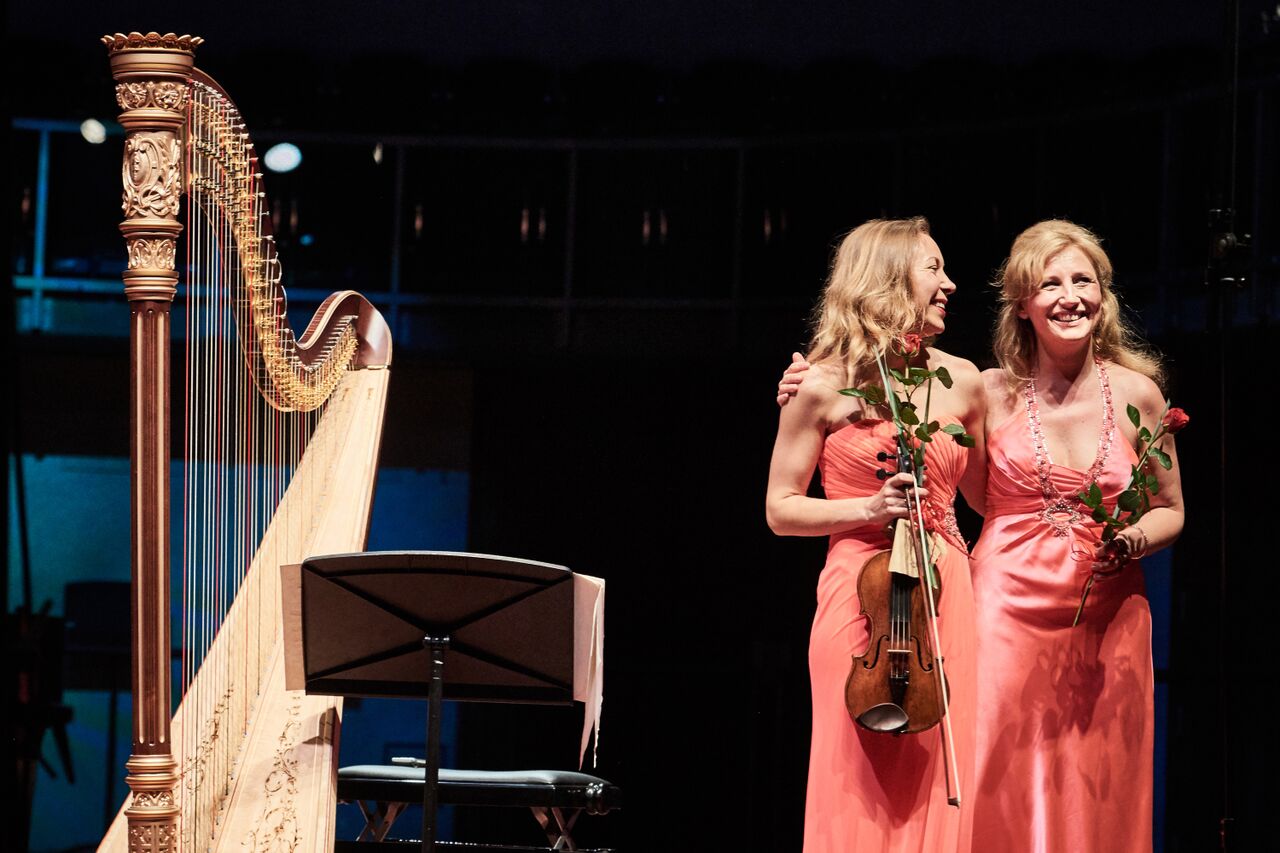 Either side of this central triptych were more wonders. Bloxham, faced with the difficulty of finding a quarter-hour piano quintet, had unearthed two movements of a Lalo rarity, arresting in parts - the unaccompanied cello opening and the big slow-movement melody - and conventional in others. The woodwind bewitched in Barber’s bittersweet Summer Music, and the top strings led by Donderer in Brahms’s Second String Sextet, sounding so Indian-summery in this sophisticated performance but actually a middle-period (1867) masterpiece. We could have sat through hours more, and there was a neat extension in a late-night chamber concert of Estonian music, beautifully programmed and showcasing a haunting new work by Juri Reinvere, his Concerto for Two Flutes (Maarika Järvi and Moonika Mattiesen). Its moody nocturnal ambition makes it sound and feel much bigger than its modest length or the forces involved (including the Academy Chamber Orchestra).
Either side of this central triptych were more wonders. Bloxham, faced with the difficulty of finding a quarter-hour piano quintet, had unearthed two movements of a Lalo rarity, arresting in parts - the unaccompanied cello opening and the big slow-movement melody - and conventional in others. The woodwind bewitched in Barber’s bittersweet Summer Music, and the top strings led by Donderer in Brahms’s Second String Sextet, sounding so Indian-summery in this sophisticated performance but actually a middle-period (1867) masterpiece. We could have sat through hours more, and there was a neat extension in a late-night chamber concert of Estonian music, beautifully programmed and showcasing a haunting new work by Juri Reinvere, his Concerto for Two Flutes (Maarika Järvi and Moonika Mattiesen). Its moody nocturnal ambition makes it sound and feel much bigger than its modest length or the forces involved (including the Academy Chamber Orchestra).
Pärnu’s annual children’s concert took place, owing to stormy weather, not in the grounds but in the main hall of the heavy art-nouveau Villa Ammende, now a luxury hotel, with sophisticated delivery and presentation of Arvo Pärt’s little-known Childhood Stories by the charming girls (plus one plucky boy) of young troupers Tahekillud. The glowing arrangements of the piano-accompanied originals were made by singer and choral conductor Kadri Hunt to include several top EFO artists alongside pianist and accordion.
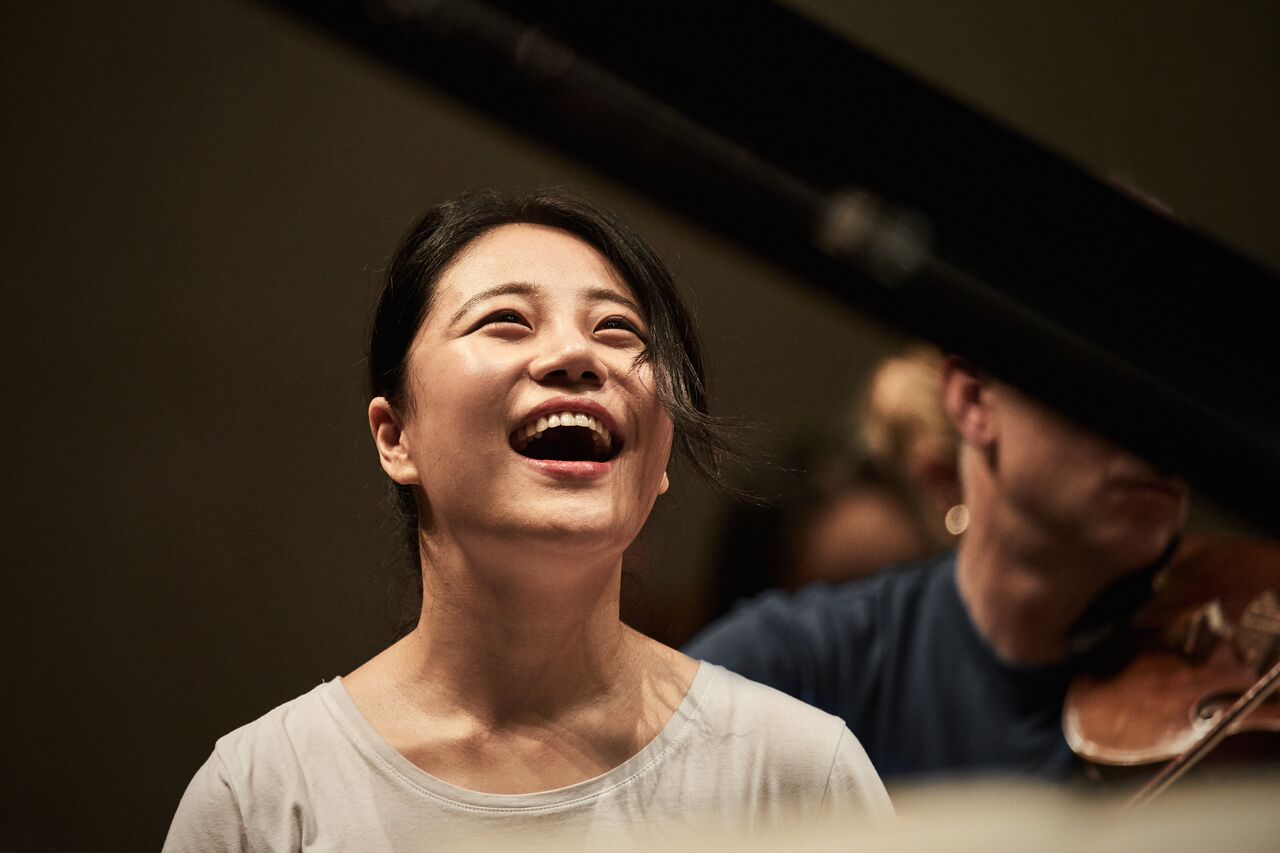 Any disappointment that an indisposed Matthias Goerne and the music he was to sing, from Mahler's Des knaben Wunderhorn, were no longer there in the final concert vanished with pianist and BBC New Generation Artist Zhang Zuo’s first notes in the Beethoven First Piano Concerto. Paavo Järvi knows exactly the sort of all-for-music personalities he wants, and Zhang (pictured above, in rehearsal for the concert) fitted into the ethos with vivacious spirit.
Any disappointment that an indisposed Matthias Goerne and the music he was to sing, from Mahler's Des knaben Wunderhorn, were no longer there in the final concert vanished with pianist and BBC New Generation Artist Zhang Zuo’s first notes in the Beethoven First Piano Concerto. Paavo Järvi knows exactly the sort of all-for-music personalities he wants, and Zhang (pictured above, in rehearsal for the concert) fitted into the ethos with vivacious spirit.
Yet the highlight and denouement was always going to be Shostakovich’s Sixth Symphony, designed in its final circus-gallop-gone-malign to balance the wild original version of Musorgsky’s Night on a Bare Mountain ("so bad it’s good - brilliant, in fact," declared Paavo). I have never, anywhere, heard an orchestral unison that bore through the body like this one at the start. Climaxes raised the roof, but precisely; the maverick structure whereby two far from light scherzos follow one long slow movement struck home.
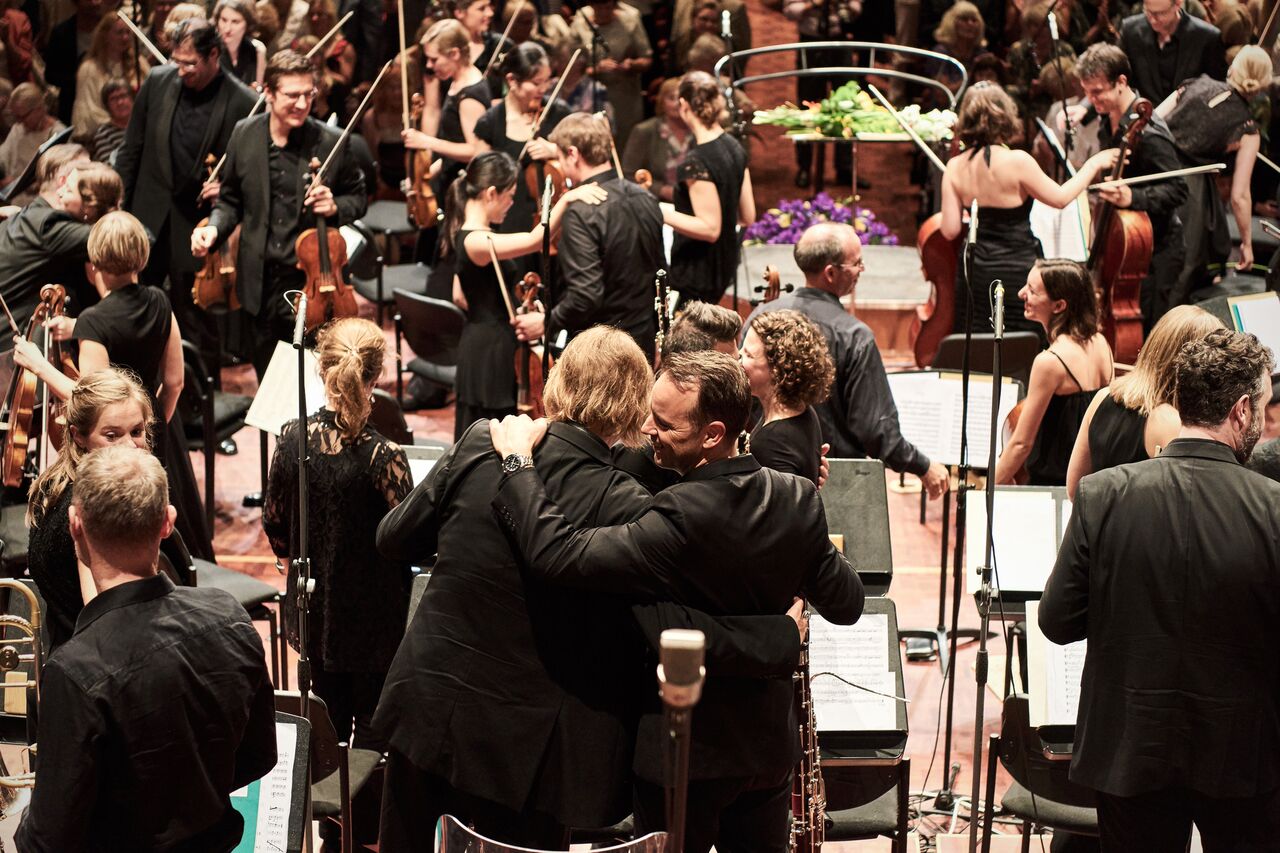 Despite the typically loving embraces at the end of the concert (pictured above), no-one was much in the mood for lively chit-chat at the reception afterwards, but come 2 am and the last of the night-to-dawn gatherings in the old town's Passion Café, a musicians' hub which makes this the friendliest and most engaging large-scale festival I’ve ever attended, spirits were revived again. With a festival like Pärnu, there’s always time for catching up on sleep once it’s all over
Despite the typically loving embraces at the end of the concert (pictured above), no-one was much in the mood for lively chit-chat at the reception afterwards, but come 2 am and the last of the night-to-dawn gatherings in the old town's Passion Café, a musicians' hub which makes this the friendliest and most engaging large-scale festival I’ve ever attended, spirits were revived again. With a festival like Pärnu, there’s always time for catching up on sleep once it’s all over
- David Nice's blog on the delights of Pärnu in 2015 and on a visit to Kihnu island during this year's festival















Add comment